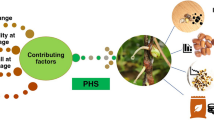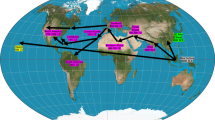Abstract
Background
Lignocellulosic biomass from rice straw possesses enormous potential in generating bioenergy thereby reducing the dependence of human on non-renewable fuel sources. Developing rice varieties of such calibre necessitates biochemical characterization as well as assessing the presence of genetic diversity among the rice genotypes with respect to cellulose content.
Methods and results
Forty-three elite rice genotypes were selected for biochemical characterization and SSR marker-based genetic fingerprinting. For genotyping, 13 cellulose synthase specific polymorphic markers were used. The diversity analysis was performed using TASSEL 5.0 and GenAlE × 6.51b2, software program. Of the 43 rice varieties, CR-Dhan-601, CR-Dhan-1014, Mahanadi, Jagabandhu, Gouri, Samanta and Chandrama were found to possess desirable lignocellulosic composition with respect to harnessing green fuels. The marker OsCESA-1.3 expressed the highest PIC (0.640), while the marker OsCESA-6.3 of lowest PIC (0.128). A moderate average estimate (0.367) of PIC was observed under current set of genotypes and marker system. The dendrogram analysis grouped the rice genotypes into two principal clusters i.e., cluster I and II. Cluster-II is monogenetic, while cluster-I is having 42 genotypes.
Conclusions
The moderate level of both PIC and H average estimates indicate the narrow genetic bases of the germplasms. The varieties falling under different clusters possessing desirable lignocellulosic composition can be used in a hybridization programme to develop bioenergy efficient varieties. The promising varietal combinations that can be used as parents for developing bioenergy efficient genotypes are Kanchan / Gobinda, Mahanadi / Ramachandi, Mahanadi / Rambha, Mahanadi / Manika, Rambha / Manika, Rambha / Indravati and CR-Dhan-601 / Manika as they offer an advantage of higher cellulose accumulation. This study helped in identification of suitable dual purpose rice varieties for biofuel production without compromising food security.






Similar content being viewed by others
References
Dash M, Mishra A, Mohanty MK (2021) Breeding Rice for Sustainable Bioenergy Production. In Integrative Advances in Rice Research. IntechOpen. London, United Kingdom. pp 109–127. https://doi.org/10.5772/intechopen.98572
Ali I, Bahaitham H, Naebulharam R (2017) A comprehensive kinetics study of coconut shell waste pyrolysis. Bioresour Technol 235:1–11. https://doi.org/10.1016/j.biortech.2017.03.089
Kaur R, Gera P, Jha MK, Bhaskar T (2018) Pyrolysis kinetics and thermodynamic parameters of castor (Ricinus communis) residue using thermogravimetric analysis. Bioresour Technol 250:422–428. https://doi.org/10.1016/j.biortech.2017.11.077
Pal DB, Tiwari AK, Srivastava N, Hashem A, Abd Allah EF (2021) Thermal studies of biomass obtained from the seeds of Syzygium cumini and Cassia fistula L. and peel of Cassia fistula L. fruit. Biomass Convers Biorefin 1–12. https://doi.org/10.1007/s13399-021-01492-z
Bhattacharyya P, Bhaduri D, Adak T, Munda S, Satapathy BS, Dash PK, Padhy SR, Pattanayak A, Routray S, Chakraborti MJ, Baig MJ (2020) Characterization of rice straw from major cultivars for best alternative industrial uses to cutoff the menace of straw burning. Ind Crop Prod 143:111919. https://doi.org/10.1016/j.indcrop.2019.111919
Carroll A, Specht CD (2011) Understanding plant cellulose synthases through a comprehensive investigation of the cellulose synthase family sequences. Front Plant Sci 2:5. https://doi.org/10.3389/fpls.2011.00005
Choudhury B, Khan ML, Dayanandan S (2013) Genetic structure and diversity of indigenous rice (Oryza sativa) varieties in the Eastern Himalayan region of Northeast India. Springer Plus 2:1–10. https://doi.org/10.1186/2193-1801-2-228
Sow M, Ndjiondjop MN, Sido A, Mariac C, Laing M, Bezançon G (2014) Genetic diversity, population structure and differentiation of rice species from Niger and their potential for rice genetic resources conservation and enhancement. Genet Resour Crop Evol 61:199–213. https://doi.org/10.1007/s10722-013-0026-9
Courtois B, Frouin J, Greco R et al (2012) Genetic diversity and population structure in a european collection of rice. Crop sci 52:1663–1675. https://doi.org/10.2135/cropsci2011.11.0588
Botstein D, White RL, Skalnick MH, Davies RW (1980) Construction of a genetic linkage map in man using restriction fragment length polymorphism. Am J Hum Genet 32:314–331 PMID: 6247908; PMCID: PMC1686077
Liu BH (1998) Statistical genomics: linkage, mapping and QTL analysis, 1st edn. CRC Press, Boca Raton, pp 1–648. https://doi.org/10.1201/9780203738658
Powell W, Morgante M, Andre C, Hanafey M, Vogel J, Tingsey S, Rafalski A (1996) The utility of RFLP, RAPD, AFLP and SSR (microsatellite) markers for germplasm analysis. Mol Breed 2:225–238. https://doi.org/10.1007/BF00564200
Nagaraju J, Damodar RK, Nagaraja GM, Sethuraman BN (2001) Comparison of multilocus RFLPs and PCR-based marker systems for genetic analysis of the silkworm, Bombyx mori. Heredity 86:588–597. https://doi.org/10.1046/j.1365-2540.2001.00861.x
Sahoo JP, Samal KC, Lenka D, Beura SK, Behera L, Khamari B, Sawant SB (2022) Assessment of genetic diversity for Cercospora Leaf Spot (CLS) Resistance in Mung Bean [Vigna radiata (L.) Wilczek] using SSR markers. Legume Res. https://doi.org/10.18805/LR-4985
Mishra A, Mishra TK, Nanda S et al (2022a) Bioenergy potential of different varieties of paddy straw biomass. Bioresour Technol Rep 20:101229. https://doi.org/10.1016/j.biteb.2022.101229
Mishra A, Nanda S, Parida MR et al (2022) A comparative study on pyrolysis kinetics and thermodynamic parameters of little millet and sunflower stems biomass using thermogravimetric analysis. Bioresour Technolo 128231. https://doi.org/10.1016/j.biortech.2022.128231
Das N, Jena PK, Padhi D et al (2021) A comprehensive review of characterization, pretreatment and its applications on different lignocellulosic biomass for bioethanol production. Biomass Convers Biorefinery 1–25. https://doi.org/10.1007/s13399-021-01294-3
Rashmi D, Bisen P, Saha S, Loitongbam B, Singh S, Singh PK (2017) Genetic diversity analysis in rice (Oryza sativa L.) accessions using SSR markers. Int J Agric Environ Biotechno 10:457–467
Suvi WT, Shimelis H, Laing M, Mathew I, Shayanowako AIT (2020) Assessment of the genetic diversity and population structure of rice genotypes using SSR markers. Acta Agric Scand B Soil Plant Sci 70:76–86. https://doi.org/10.1080/09064710.2019.1670859
Hoque MI, Islam MM, Begum SN, Yasmine F, Khanom MSR (2021) Genetic diversity analysis of Rice (Oryza sativa L.) Landraces using SSR markers in Bangladesh. SAARC J Agric 19:13–25. https://doi.org/10.3329/sja.v19i2.57669
Kumar SP, Susmita C, Sripathy KV et al (2022) Molecular characterization and genetic diversity studies of indian soybean (Glycine max (L.) Merr.) Cultivars using SSR markers. Mol Biol Rep 49:2129–2140. https://doi.org/10.1007/s11033-021-07030-4
Nachimuthu VV, Robin S, Sudhakar D et al (2014) Genotypic variation for micronutrient content in traditional and improved rice lines and its role in biofortification programme. Indian J Sci Technol 7:1414–1425
Pathaichindachote W, Panyawut N, Sikaewtung K, Patarapuwadol S, Muangprom A (2019) Genetic diversity and allelic frequency of selected thai and exotic rice germplasm using SSR markers. Rice Sci 26(6):393–403. https://doi.org/10.1016/j.rsci.2018.11.002
Vasumathy SK, Alagu M (2021) SSR marker-based genetic diversity analysis and SNP haplotyping of genes associating abiotic and biotic stress tolerance, rice growth and development and yield across 93 rice landraces. Mol Biol Rep 48:5943–5953. https://doi.org/10.1007/s11033-021-06595-4
Hassan DA, Hama-Ali EO (2022) Evaluation of gene flow and genetic diversity in rice accessions across Kurdistan region-iraq using SSR markers. Mol Biol Rep 1–10. https://doi.org/10.1007/s11033-021-06920-x
Begum S, Reddy V, Srinivas B, Arunakumari CH (2020) Heterosis studies for yield and physical quality traits in hybrid rice (Oryza sativa L). J Crop Weed 16:38–50
Acknowledgements
This work was supported by the Bharat Petroleum Corporation Limited, New-Delhi, India.
Funding
This study was supported by the Bharat Petroleum Corporation Limited, New-Delhi, India.
Author information
Authors and Affiliations
Contributions
“All authors contributed to the study conception and design. Conceptualization and data interpretation was done by Abinash Mishra and Manasi Dash. Material preparation, conduct of experiment, data collection and analysis were performed by Abinash Mishra, Jyoti Prakash Sahoo, Bishnupriya Swain and Spandan Nanda. The first draft of the manuscript was written by Abinash Mishra and checked by Manasi Dash. All authors commented on previous versions of the manuscript. All authors read and approved the final manuscript.”
Corresponding author
Ethics declarations
Competing Interests
“The authors have no relevant financial or non-financial interests to disclose.”
Ethics approval
This article does not contain any studies with human participants or animals performed by any of the authors.
Additional information
Publisher’s Note
Springer Nature remains neutral with regard to jurisdictional claims in published maps and institutional affiliations.
Rights and permissions
Springer Nature or its licensor (e.g. a society or other partner) holds exclusive rights to this article under a publishing agreement with the author(s) or other rightsholder(s); author self-archiving of the accepted manuscript version of this article is solely governed by the terms of such publishing agreement and applicable law.
About this article
Cite this article
Mishra, A., Sahoo, J.P., Swain, B. et al. Biochemical and SSR based molecular characterization of elite rice varieties for straw lignocellulose. Mol Biol Rep 50, 5535–5545 (2023). https://doi.org/10.1007/s11033-023-08454-w
Received:
Accepted:
Published:
Issue Date:
DOI: https://doi.org/10.1007/s11033-023-08454-w




